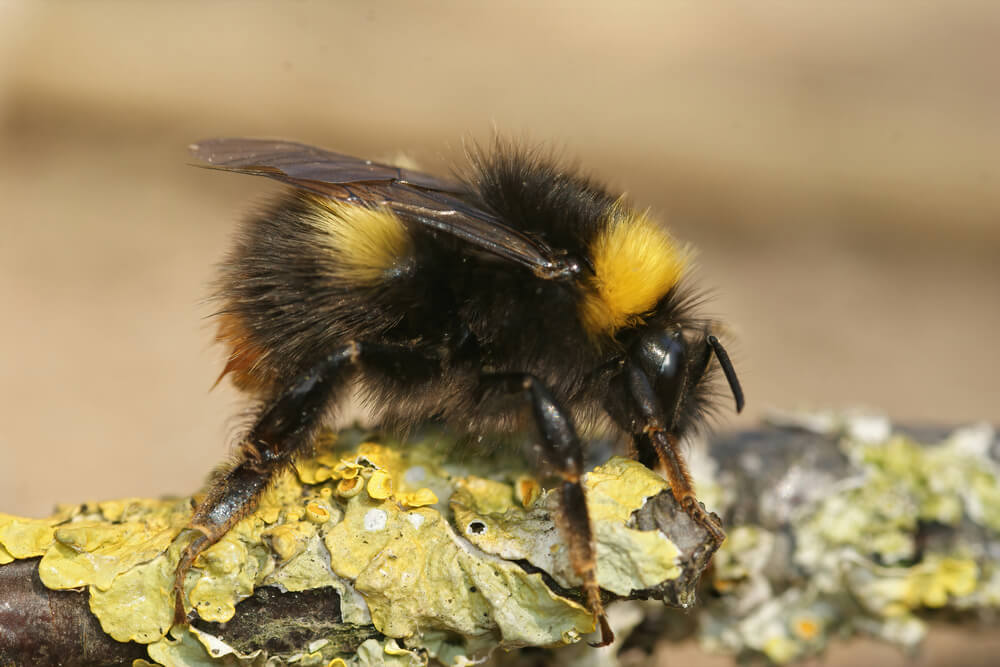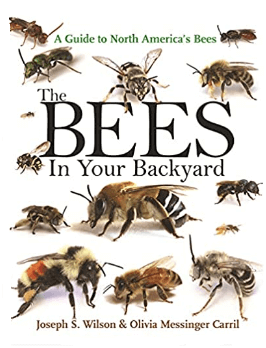Table of Contents:
Where Do Bumblebees Live?
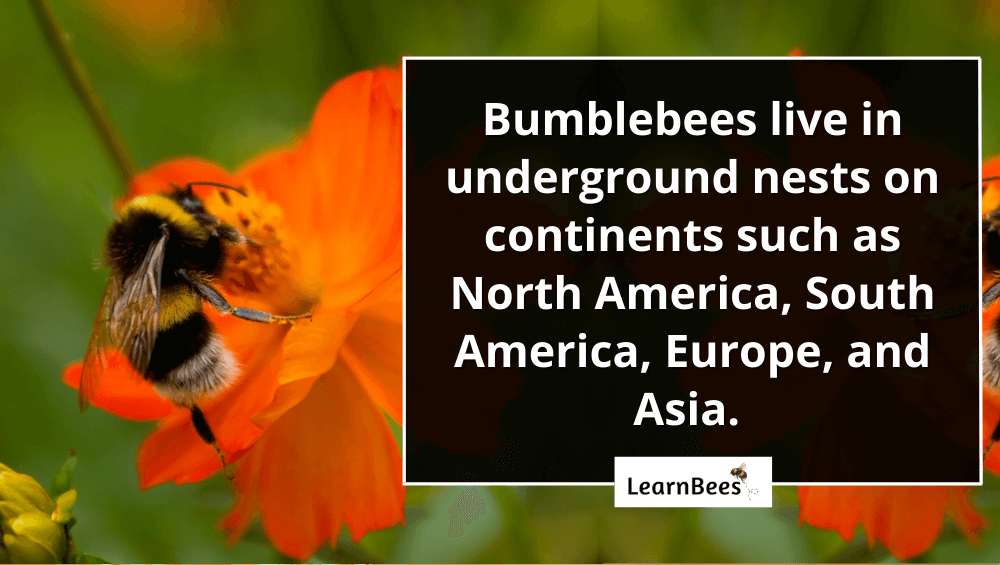
There are more than 250 bumblebee species, and they’re found all over the world. Bumblebees are located everywhere from Argentina to the United States to Ireland.
And here’s a fact that might surprise you:
Queen bumblebees are one of the largest bees native to the United States.
And thanks to their size and friendly nature, bumblebees are nicknamed ‘gentle giants.’ They only sting if they feel seriously threatened, like if you’re trying to grab them or poke your fingers around their nests.
Speaking of bumblebee nests, they’re most commonly found concealed underground in empty rodent holes or other cavities.
In fact, bumblebee nests are often so hidden that you may not realize they’re there.
This is because queen bumblebees are selective about their nesting sites. They try to pick safe locations to house the entire bumblebee colony.
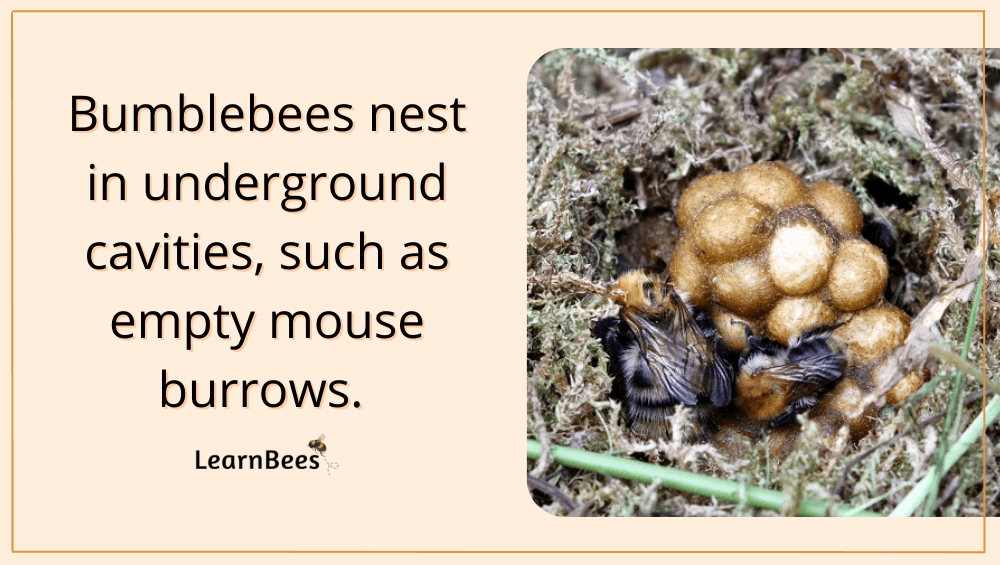
Keep in mind:
Safety is essential for bumblebees because they have many predators.
Despite popular belief, bumblebees are a type of bee that makes honey. They don’t make nearly as much honey as honeybees, but they can still produce enough to become targets for honey-loving animals like bears or honey badgers.
Additionally, many animals like to feast on bees and their larvae. Skunks, birds, and even spiders have been known to eat bumblebees for a snack.
In fact, a skunk can destroy a bumblebee hive in a matter of minutes.
Not good.
This is why it’s important to give bumblebees space when it comes to their nests. A bumblebee colony’s main job is to protect themselves, their queen, and the baby bumblebees from potential intruders.
As a result, you don’t want bumblebees to mistake you as a threat accidentally.
With that in mind, pay attention to the bumblebee’s warning signs if you’ve stumbled upon their nest. Warning signs include buzzing over your head or around your face.
The good news?
Bumblebees are typically docile creatures that mind their business.
As long as you don’t go poking around their hive, you usually don’t have anything to worry about from these gentle giants.
Do Bumblebees Live Alone?
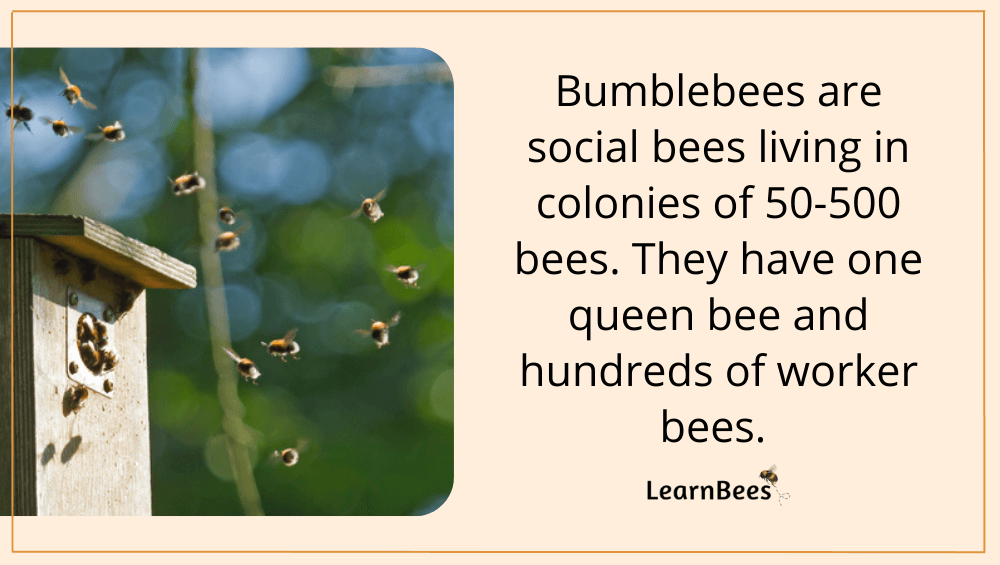
No, bumblebees are actually social creatures that live in colonies.
Bumblebees are similar to honeybees in this way, as both types of bees live together in large groups. Depending on the bumblebee species, they can have as many as 500 bumblebees in a single colony.
And here’s the thing:
The colony is led by a female bumblebee, also known as the queen. The queen is the only member of the colony that can lay eggs, which makes her responsible for populating the hive.
The rest of the colony is made up of worker bees, which are all female. Worker bees are responsible for caring for the hive by collecting nectar and pollen, making honey, and feeding the larvae.
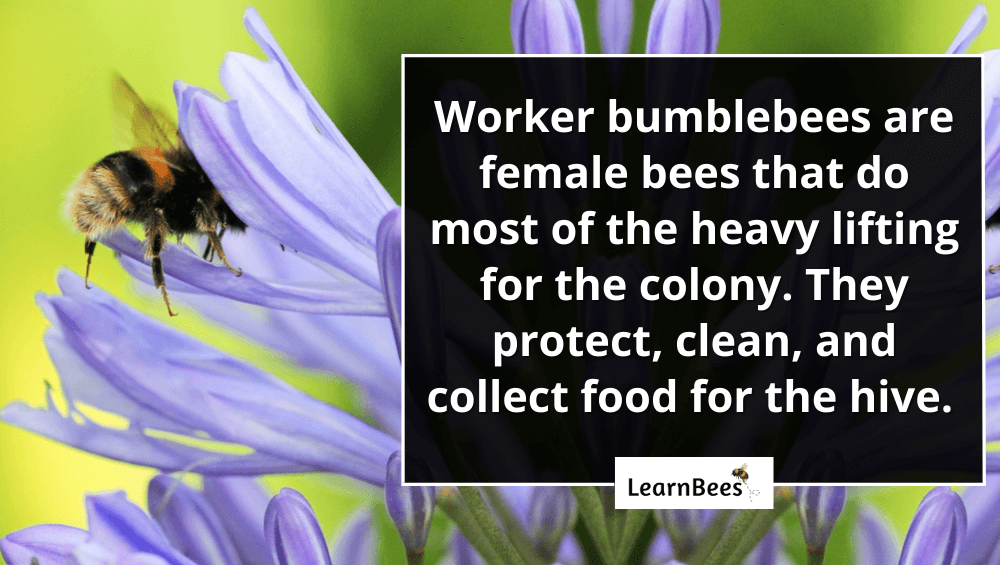
Male bumblebees, or drones, don’t do much except mate with queens from other hives. Once they’ve mated, their purpose is fulfilled, and they don’t live much longer after.
With that in mind, most people are shocked to learn that bumblebee colonies mainly consist of females. As mentioned, female bumblebees are responsible for most of the labor in the hive.
From protecting the colony to foraging for food, worker bumblebees do it all. They’re essential to the colony’s survival and play a big role in keeping the hive running smoothly.
So, in a nutshell:
Queen bumblebees are responsible for laying eggs, male bumblebees are responsible for mating, and worker bumblebees do almost everything else.
Bee colonies are run like a well-oiled machine, with every bee performing a task they were born to do.
How Do I Find a Bumblebee Nest?
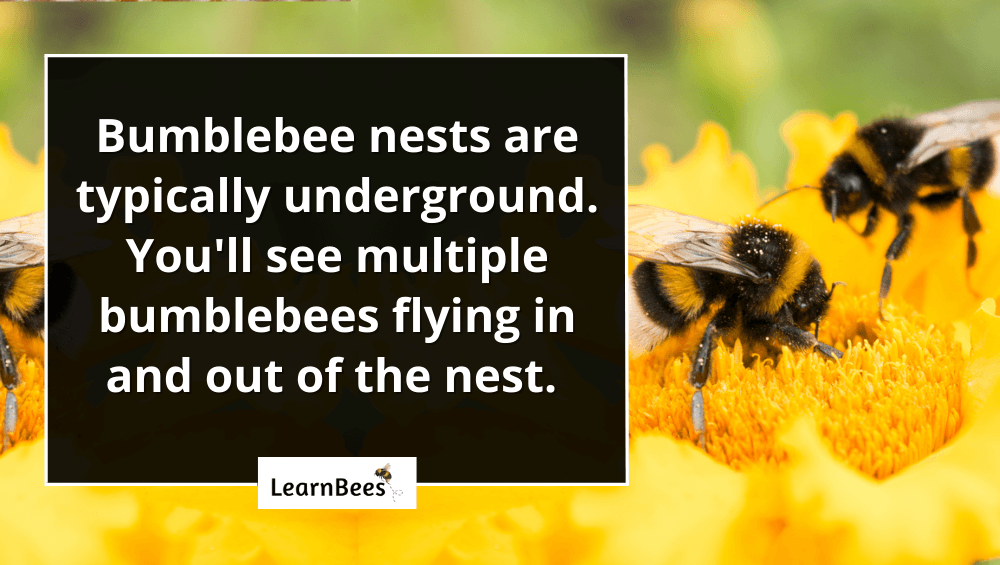
Bumblebees are pretty good at hiding their nests. This is because they’re constantly under threat from predators looking for an easy meal.
However, the best way to find a bumblebee nest is to be aware of underground cavities where they might be drawn to. You can watch for bumblebees flying in and out of these potential hiding spots to see if there’s a nest present.
Another way to find a bumblebee nest is to look for telltale signs of a hive, such as hearing a hum or buzzing noise near empty cavities in the ground.
But remember:
It’s important not to disturb bee nests because bees are essential pollinators.
It’s estimated that one in every three bites of food we eat is thanks to pollinators like bumblebees, honeybees, and mason bees.
In other words:
Without pollinators, we wouldn’t have nearly as much food to eat.
This is why it’s so important to leave bee nests alone and give them the space they need to thrive.
FAQs on “Where Do Bumblebees Live?”
- Where do bumblebees live in the world?
- Do bumblebees live underground?
- Do bumblebees live alone?
- Where do bumble bees go at night?
- Do bumble bees nest in houses?
- Will a bumblebee chase you if you’re near their nest?
- Why are there so many bumble bees in my yard?
- How many bumblebees live in a nest?
- Why am I finding bumble bees in my house?
- How do you tell if you have a bumblebees nest?
- Do bumble bees nest in roofs?
- Do bumble bees nest in chimneys?
- Where do bumblebees live in the winter?
- What happens if you block the entrance to a bumblebees nest?
Where do bumblebees live in the world?
Bumblebees are found worldwide, in places like South America, North America, Europe, and Asia.
—> Go back to the FAQs on “Where Do Bumblebees Live?”
More to Explore:
Do bumblebees live underground?
Yes, bumblebees often build their nests in underground cavities, like abandoned caves or holes in the ground. You may be able to find a nest by watching for bees flying in and out of such areas. With that in mind, it’s important to give bees the necessary space and not disturb their nests.
Despite being docile creatures, bumblebees will defend their nests if they feel threatened.
—> Go back to the FAQs on “Where Do Bumblebees Live?”
More to Explore:
- Do Bumble Bees Make Honey?
- How Long Do Bumble Bees Live?
- Carpenter Bee vs. Bumble Bee: What’s the Difference?
Do bumblebees live alone?
No, bumblebees live in colonies ranging in size from 50 to 500 bees. They’re considered ‘social bees’ because of these family units.
—> Go back to the FAQs on “Where Do Bumblebees Live?”
More to Explore:
Where do bumble bees go at night?
Bumblebees are the most active during the day when they can forage for food on flowers. At night, bees go back to their nests to rest. However, some bumblebees remain active inside the nests at night while the other bumblebees are sleeping. These ‘night shift’ bees help keep the hive clean and take care of the other colony member.
—> Go back to the FAQs on “Where Do Bumblebees Live?”
More to Explore:
Do bumble bees nest in houses?
Bumblebees can nest in houses, but it’s not as common as you think.
Honeybees and carpenter bees are the two most common bee species that nest in houses. For example, honeybees will search for small openings, like cracks in the siding or gaps around windows, to build their nests.
On the other hand, carpenter bees create their nests by drilling holes into wood.
Bumblebees are often mistaken for carpenter bees because they look similar. However, they’re two different species of bees with different nesting habits. That said, both carpenter bees and bumblebees are crucial pollinators.
—> Go back to the FAQs on “Where Do Bumblebees Live?”
More to Explore:
Will a bumblebee chase you if you’re near their nest?
Bumblebees will hover around you as a warning sign that you’re getting too close to their nest. However, they generally won’t chase you apart from that.
For example, if you see a bumblebee buzzing around a flower, then there’s usually nothing to worry about. The bumblebee is simply going about its business collecting pollen and nectar.
On the other hand, if you see a bumblebee flying close to your face or body, it’s probably trying to warn you to back away from a nest nearby. In this case, it’s best to listen to the bumblebee and give it some space.
—> Go back to the FAQs on “Where Do Bumblebees Live?”
More to Explore:
Why are there so many bumble bees in my yard?
Bumblebees are attracted to flowers because that’s where they get their food from – aka pollen and nectar. So if you have flowers in or around your yard, that’s probably why you see so many bumblebees.
Additionally, you may see bumblebees in your yard if they’re nesting there. Don’t be alarmed. Bumblebees are gentle creatures that won’t go out of their way to disturb you. Simply give them several feet of distance from their nests, and you should be fine.
—> Go back to the FAQs on “Where Do Bumblebees Live?”
More to Explore:
How many bumblebees live in a nest?
Bumblebees live in colonies that can have anywhere from 50 to 500 members. Bumblebee colonies often reach their peak size during summer and then die off in the late fall.
Spring and summer are peak months for bumblebees because plenty of flowers bloom during those months. The flowers provide the bees with food (pollen and nectar), which they need to survive.
As the weather cools down in the fall, fewer flowers bloom. This lack of food can cause the bumblebee colony to dwindle in size. By winter, only the queen bumblebees are left, and they go into hibernation.
—> Go back to the FAQs on “Where Do Bumblebees Live?”
More to Explore:
Why am I finding bumble bees in my house?
There are a few reasons why you might find a bumble bee in your house.
First, the bees could be slipping through cracks and crevices in the exterior of your house. This is more likely to happen if you have a lot of flowers blooming near your home.
Second, bumble bees might come into your house through open doors and windows. Again, this is more likely to happen if flowers are blooming nearby.
Finally, bumblebees may have taken up residence in your house. This is more likely to happen if there’s a hole or crack in your walls that the bee can use to access the inside of your home. If this is the case, please get in touch with a local beekeeper to safely relocate the nest without harming the bumblebees.
—> Go back to the FAQs on “Where Do Bumblebees Live?”
More to Explore:
How do you tell if you have a bumblebees nest?
The easiest way to tell is by observing the area. If you see multiple bumblebees flying in and out of a certain location, they will likely have a nest there.
Another way to tell is by listening for a buzzing sound. Bumblebees make a buzzing sound, which is amplified when multiple bees are near each other. So if you hear a faint buzzing noise, it could be coming from a bumblebee nest.
—> Go back to the FAQs on “Where Do Bumblebees Live?”
More to Explore:
Do bumble bees nest in roofs?
Bumblebees have been known to nest inside cavities near roofs. However, this is relatively rare. More often, bumblebees will build their nests in the ground.
If you think there might be a bumblebee nest in your roof, contacting a local beekeeper is best. They’ll be able to remove the nest without harming the bees.
—> Go back to the FAQs on “Where Do Bumblebees Live?”
More to Explore:
Do bumble bees nest in chimneys?
Bumblebees have been known to nest inside chimneys. However, this isn’t common. More often, bumblebees will build their nests in the ground.
If you think there might be a bumblebee nest in your chimney, contacting a local beekeeper is best because they’ll relocate the nest without hurting the bumblebees.
—> Go back to the FAQs on “Where Do Bumblebees Live?”
More to Explore:
Where do bumblebees live in the winter?
When the weather gets cold in the fall, the queen bumblebees mate and then go into hibernation. The rest of the colony dies off before the winter arrives. Bumblebees hibernate during the winter because there aren’t any flowers blooming, so there’s no food (pollen and nectar) for them to eat.
During the winter, the queen bumblebees hibernate in underground nests. These nests provide them with shelter and insulation from the cold weather.
In the spring, the queen bumblebees wake up from hibernation and start to build new nests. This is when the colony starts to grow again.
—> Go back to the FAQs on “Where Do Bumblebees Live?”
More to Explore:
What happens if you block the entrance to a bumblebees nest?
This can disturb the colony and cause the bees to become agitated. If you block the entrance to a bumblebee’s nest to the point where they can’t get out, the colony will die. Please don’t disturb bumblebees or other bee species, as they’re vital pollinators for our ecosystems.
